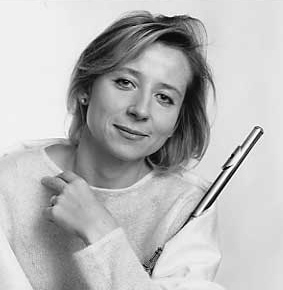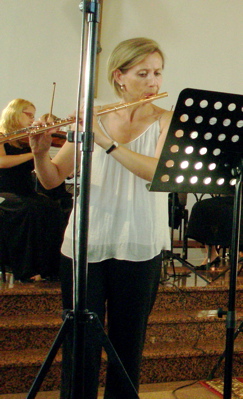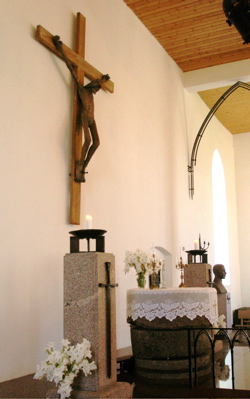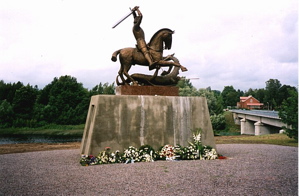Oistrakh Festival Concert Commemorates Estonian Independence with Estonian Music
Mary Ellyn Hutton
Posted: Jul 30, 2008 - 5:02:47 PM in
reviews_2008

Maarika Jarvi
|
Tori, Estonia.
There was a solemn ceremony before the David Oistrakh Festival concert July 25 in the Memorial Church of the Estonian Soldiers in Tori, a small town northeast of Pärnu.
Archbishop Andres Poder of the Estonian Evangelical Lutheran Church lit a candle and prayed before a black granite plaque mounted at the head of the church.
This plaque, however, is unlike the others than line the walls of the nationally hallowed spot, originally a parish church built in 1854, lovingly restored after Estonian re-independence in 1991.
Instead of lists of fallen soldiers, this newest plaque bears the inscription “in memory of all the repressed musicians.” So it was wholly fitting that the concert was conducted by participants in this year’s Neeme Järvi Summer Academy, a master course for young conductors held in conjunction with the Oistrakh Festival since 2000.
Järvi himself led one selection, the 2001 flute concerto “Leonides” by Estonian Urmas Sisask (born 1960). Soloist with the Estonian National Youth Symphony Orchestra was Maarika Järvi, for whom the work was written.
One of the top conductors in the former Soviet Union, Jarvi left Estonia in 1980 under threat of repression, having angered the authorities for programming music unapproved by the Communist regime. (Järvi’s name was excised from print, his recordings aired without attribution and he and his family, including wife Liilia, daughter Maarika and sons Paavo and Kristjan, were declared enemies of the Soviet people when they emigrated.)
Now a naturalized American citizen, Jarvi returns to a free Estonia in the summers to conduct and preside over his Suveakadeemia.
Järvi programmed all-Estonian music for the July 25 concert in honor of the 90th anniversary of the Estonian Republic. (The 50-year, post-war Soviet occupation, in violation of the 1920 Treaty of Tartu between Estonia and Bolshevik Russia whereby the latter recognized Estonia’s freedom “forever” from Russian rule, did not extinguish its legal independence.)
In addition to “Leonides,” there was music by Arvo Part, Villem Reimann (1906-92) and Helmut Rosenvald (born 1929). Acoustics in the church were warm and welcoming, favoring soloist and ensemble alike.
British violinist Victoria Sutherland’s performance of Pärt’s “Fratres” with the Estonian Youth Orchestra strings and percussion led by the very talented young Estonian conductor Lehari Kaustel, 28, provided the perfect benediction to Archbishop Poder’s opening remarks.

Violinist Victoria Sutherland
|
Her judicious use of vibrato and mix of serenity and passion haloed the solemnity of the occasion.
Sisask’s “Leonides” was inspired by the annual meteor shower emerging from the constellation Leo when Earth approaches the trajectory of comet Temple-Tuttle. The composer witnessed a mega-shower in 1999 when, due to the proximity of the comet and Earth, the display was at its cyclical, 33-year height. He has crafted a remarkable tone picture in the single-movement, 25-minute work, which is subtitled “In memoriam: Lepo Sumera” in honor of the late Estonian composer.
A musical theorist with an astronomical bent might decipher what the liner notes to Jarvi’s 2001 recording (“Celestials” for Ccn’c) assert is a harmonic shape similar to constellation Leo itself. Sisask is fascinated by such phenomena and has blended music and astronomy in many of his works. (He has even created a five-note scale based on the trajectories of the planets in our solar system.)
The two Järvi’s enhanced the performance with a bit of stage direction. The concerto opens with a 98-bar flute solo, a simple melody that expands into an undulating, flickering cadenza.

Maarika Jarvi performing Urmas Sisask's "Leonides," Memorial Church of the Estonian Soldiers, Tori, Estonia
|
Järvi -- in effect the comet -- entered from behind the orchestra, walking slowly around to her place beside the first violins.
Conductor Järvi met her there, having made his own entrance beside the double basses, giving them the cue for a soft pedal note which led into the orchestral tutti. The “show” really began in the ensuing tango section, which might be called the Estonian “Bolero” (Ravel needs a rest and this attractive, inventive work could do the job).
Bolero-like rhythms in the basses crept in as Järvi soared to a fortissimo high note. It was as if Earth and the comet had crossed orbits, loosing the celestial fireworks.
The strings all have individual parts, allowing them to crisscross in and out of the fabric like meteors crossing the sky. Sisask achieves this in highly effective ways: sudden tremolo fortepianos, rapid scale-like passages, glissandos -- all with dynamic shaping, usually crescendo to fortissimo. My favorite was the open-string concussion, which followed downward glissandos. One really got the feeling of meteors whizzing by.
All this transpired over an infectious tango melody, which broke out full-voice at intervals. (Marius Järvi, Maarika’s cousin, could be spotted playing first cello.)
Järvi (the comet) swirled merrily over the mix, leaving the orchestral melee behind as she reiterated the simple melody with which she began. There were occasional flares from the orchestra in her trail, but the cosmic event had ended and she made her return journey behind the orchestra. For his part, conductor Järvi, who had a field day cueing all the starburst activity, exited beside the basses, to whom he signaled the ending.
Sisask, who was present, shared in a very enthusiastic ovation from the capacity crowd.
Vallem Reimann’s Dramatic Suite ( 1961) was led by five Academy conductors: Estonian Valdo Ruutelmaa, New Zealander Rachel Young, now living in London, Frenchman Jean-Philippe Dambreville and Jerry Hou and Shy-Luen Chen, both originally from Taiwan.
It is an engaging and colorful work. The opening Prelude, led by Ruutelmaa, had the archaic flavor of Respighi’s “Catacombs” (“Pines of Rome”) and as Järvi and Gallic-born Dambreville agreed in a master course session, “Musical Moment” cheerfully partook of Bizet. Young communicated charm in the lightweight “Dream,” while the funereal “Mourning Scene,” led by Hou, was grave and dignified. It was up to Chen to capture the aching nostalgia of the Finale, which he did commendably.
The conductors selected for Rosenvald’s Classical Symphony (1977) had a different challenge. Scored for strings and timpani, it is somewhat turgid and hard to grasp on first hearing (if astronomy is Sisask's thing, chess is Rosenvald's). American conductor Sameer Patel cleanly contrasted the celebratory and agitated sections of the opening Allegro. Briton Tim Carey did admirably by the Andante, a removed, ambiguous movement ending with spooky harmonics in the first violins.
Robin Browning, also of Britain, gave bluster to the Molto Vivace scherzo with its quirky rhythms and hammered, fortissimo ending. Scotsman Heron handled the complex finale admirably. It began like a threnody with heavy, dotted, sobbing rhythms, morphed into a fugue, built to at a joyful, almost-chorale, then returned to the despondent manner in which it began, this time pianissimo and vibrato-less, with a soft hollow pizzicato at the end.
The encore was Heino Eller's uplifting Kodumaine viis ("Homeland Tune") led with energy and enthusiasm by long-time Academy participant and de facto Oistrakh Festival principal guest conductor, Kiyotaka Teraoka.
Immediately following the concert, certificates were awarded to the ten 2008 Summer Academy graduates. Congratulations and acknowledgements were made, including a round of heartfelt applause for this year's hard-working, selfless Academy producer, Holger Kaasik.
The Memorial Church in Tori is a story in itself. The original 19th-century stone edifice was destroyed by fire during the Nazi retreat from Estonia in World War II. The restoration incorporates a military theme, with black, wrought iron fixtures and broadswords on pedestals flanking the altar beneath a large wooden figure of Christ on the cross.

Altar at Memorial Church of the Estonian Soldiers, Tori, Estonia
|
A black granite columbarium with niches for cremated remains lines the wall in the left transept of the church, and an equestrian statue of St. George and the Dragon stands outside near the banks of the Pärnu River.

Saint George slaying the dragon, Memorial Church of the Estonian Soldiers, Tori, Estonia
|
By contrast (and for hope, no doubt), a shower of white butterflies hangs from the large chandelier in the nave.





